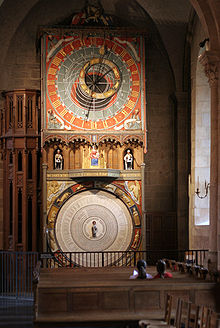
Lund astronomical clock, occasionally and at least since the 16th century referred to as Horologium mirabile Lundense (Latin: "the wonderful clock in Lund"),[1] is a 15th-century astronomical clock in Lund Cathedral. Mentioned in written sources for the first time in 1442, it was probably made and installed sometime around 1423–1425, possibly by Nikolaus Lilienfeld. It is part of a group of related medieval astronomical clocks found in the area around the south Baltic Sea. In 1837 the clock was dismantled. Between 1909 and 1923, it was restored by the Danish clockmaker Julius Bertram-Larsen and the Swedish architect responsible for the upkeep of the cathedral, Theodor Wåhlin. From the old clock, the face of the clock as well as the mechanism, which was largely replaced during the 18th century, was salvaged and re-used. The casing, most parts of the calendar which occupies the lower part, and the middle section were made anew.
The clock displays a medieval concept of time, based on a geocentric idea of the universe, and is decorated with religious symbols. It is possible to determine the current time of the day, the current lunar phase, the current position of the sun in the zodiac as well as the current date of the year and related information, from the clock. The current perpetual calendar spans from 1923 to 2123.
Two times every day, the mechanism of the clock triggers a parade of statues representing the Three Kings across the face of the astronomical clock, while a built-in organ plays the medieval tune In dulci jubilo.
- ^ Ljunghoff 1948, p. 2.